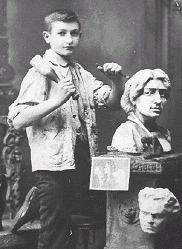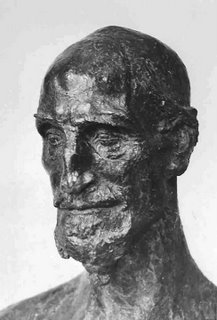The Polish Wunderkind

I was poking around the archives of the Art Institute last week -- looking up an exhibit that my art club, The Palette and Chisel, had there in 1916 -- when I discovered that the young Stanislaw Szukalski (1893-1987) had a one-man show there the same year --- when he was 23 years old !

Has this museum -- has any major museum -- given a one-man show to an artist that young ? (and looking through the show's catalog -- this was not a minor affair: there were several hundred drawings and sculptures -- although, you may notice, it only ran for 13 days)





Above are some of the pieces that would have been in that show -- kind of impressive for such a young man, aren't they ? Michelangelo made the "Pieta" when he was 24 -- but I can't think of anyone else who ran that fast out of the chute.
Soon after that first carving, father Szukalski was to leave on a long search for a better life which took him to South Africa, Brazil and eventually Chicago, Illinois, where the family followed him in 1907. So fourteen now and still drawing and sculpting, he did not speak a word of English, but decided to take charge of his own educaton by working through stacks and stacks of National Geographics foune in the family residence basement. Little else is known of these two years in Chicago except that this hyper-private education would shape Szukaliski's life forever: never again would he believe, even read, other people's theories and opinions, for he had learned, by scrutinizizing thousands of contemporary and historical pictures, everything a mortal can know.
The above is quoted from a book that was, I think, published under his direction several years later -- and appears to give an accurate presentation of his approach to learning.
He was offered his own museum in Poland during the thirties -- but his career bottomed out during the war. The museum was totally destroyed during the seige of Warsaw -- and after the war he moved to California, as a destitute and forgotten old man.

This 1928 monument to "Boleslaw the Brave" may have been the high point of his career -- and he wrote about it as follows:
Boeslaw the Righteous, called "the brave" by the church-inspired historians lived 1039-1081. The nobles formed a conspiracy against him which was joined by Stanislav Szczepanowski, bishop of Krakow, the leader of the clerical party which betrayed Poland to Germany. Boleslaw, with righeous indignation, regardless of the consequences, slew him at the altar and ordered him cut to pieces and fed to the eagles. Boleslaw was then ostrasized and forced to flee into exile.
The traitorous bishop was canonized and became the Patron Saint of the Polish nation. His remains, instead of those of the righteious Bolesaw, are suspended high above the main altar in the Wawel cathedral, Poland's equlivalent to Westminster Abbey.
This sculpture was of several years planning and premediation. I made not a single drawing note for it. So as not to bind myself by faulty sketches which would make it difficult to think of any shape other than that of the first notion, I wrote all the details in a little book: why the hero was deep in thought, why the other figures were, and what they did. It was started in Paris in 1926, on Boulevard Arage, in a studio building near the Prison de Sante. It was then moved to a village, May-en-Multien, where I had a home. It took me two and one half years to finish, and since I had a policy of never working on two pieces at the same time, this was the sole piece executed during this period. I never change anything in the composition or details once these are begun.
I had two goals in mind: to pay homage to a forgoten individual who was betrayed by his own nation, and to advance my skill on an elaborate sculpture. I feel very strongly that the Poles have an ethnic failing, a lack of "stick-to-itness", which is expressed by the Polish saying "slomiany ogien" This means that the unstable enthusiasm of the Poles is but a "straw fire". In order to overcome this ethnic failing, I planned this sculpture, resolving that I would work on it until collapsing from total exhaustion. This was my way of developing character through discipline.
The work was first executed in plastina over a much-padded armature to support the sculpture and to minimize the amount of plastina required, as it was very expensive. After a year of work, professional casters then cast it in plaster. The work of finishing with files and scrapers, many of wich I designed and made myself, went on for another year and one half. Finally it was cast in bronze, in sixty four parts and then assembled. All this time I had no finacial assistance from anyone so that I acted as philanthropist to the world of Culture.
In the sculpture I made Boleslaw he Brave reach for the flaming sword of anger, Deed, and in the swiftness of his action knock off the royal crown. With his left hand he holds the offshoot tribes from genealogical trunk of a cut tree. By his left foot the Motherland makes a mystic circle with her claws to indicated that he is her son.
I have inscribed on the pedastal these words:
When the nation had no capacity
for Anger-Indignation
it is ready for Enslavement.

Young genius ? --- Yes -- but also a poster boy for an especially masculine megalomania -- which I think is especially a problem in the 20th C. when artists were expected to be self directed.
He rejects nature (refusing, even in art school, to study the model) as well as all sculptural traditions -- except for that which he obviously picked up unawares - and as he matured -- his works just got uglier and uglier -- except for his portraits -- where he had to accept the restrictions of making a resemblance.
Now -- in the post-modern artworld -- where fame and eccentricity are admired --his posthumous career is reviving -- and websites in the U.S. and Poland are celebrating his career.
Which I think is a good thing --- but mostly as a cautionary tale.


2 Comments:
Hmmm. Thank you. It is good to read the artist's words.
I hopped over and read his bio: so chock full of wild and historically-interesting impulses and events. What fascinates me is the sense that Szukalski has created his own strange alternative world, so that his art springs from it--rather from our own. This is something that I've been thinking about in connection with Yeats: how some artists create a fantastic universe for the sake of art, and how its laws and beliefs then proceed to alter and shape the work. In Yeats, too, world-generation is linked to a kind of arrogance.
Post a Comment
<< Home